Simon Guerrier's Blog, page 14
August 9, 2024
David Whitaker postscript / Terry Nation party
You can now download for free the four-page postscript to my biography of David Whitaker, detailing some of the things I've learned since the book was published last November.
The postscript is included in The Who Shop's exclusive paperback editions of the book, and will be added to future versions of the standard paperback at some point.
To accompany the release of the postscript yesterday, I posted a thread to both X (formerly Twitter) and BluSky, and here it is in full:
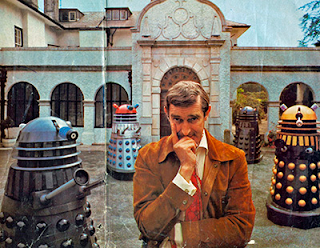 Terry Nation and pals at Lynsted Park, source
Terry Nation and pals at Lynsted Park, sourceWriter and Dalek creator Terry Nation was born on 8 August 1930. OTD in 1964, he hosted a big birthday party at his newly acquired home, Lynsted Park — an Elizabethan mansion in Kent.
You can watch footage of Nation interviewed at home by Alan Whicker in 1967 on the BBC website. But my interest is in that party.
This party haunts my imagination, symbolic of Nation becoming a big showbiz success story after years of toil in light entertainment.
But, like most of these things, the more I’ve looked into it, the richer and stranger the story gets.
I wonder about the logistics. Did Nation provide everyone’s drinks? Was good laid on as well? Given Lynsted Park was quite remote, was there a lot of drink-driving back to London?
But also, who was at this party? While in the Doctor Who production office, Nation sent an invite to actress Carole Ann Ford. (The office kept a copy: Nation to Ford, 31 July 1963, WAC T5/648/2 General)
Nation was at the time hard at work writing The Dalek Invasion of Earth, the serial that would see Ford leave Doctor Who after a year playing the Doctor’s granddaughter Susan.
On the DVD / Blu-ray commentary for The End of Tomorrow (the fourth episode of The Dalek Invasion of Earth), Ford and her colleagues recall Nation’s lavish birthday bash.
In fact, Ford remembered that Nation’s grand new house was in a bit of a state. In particular, she recalled that the swimming pool couldn’t be used; it was full of rubbish.
Co-star William Russell said Nation told him that he hadn’t bought the house because he was suddenly rich from inventing the Daleks (whose debut story had concluded earlier that year).
Instead, Nation said he’d taken out an ‘enormous mortgage’ as a spur to keep busy writing. It was a means to success, rather than a marker of success having been accomplished.
Who else was at the party? Given that Ford and Russell were there, Nation probably invited Doctor Who’s other stars — William Hartnell and Jacqueline Hill.
Hill’s husband Alvin Rakoff told me he remembered going to Lynsted Park but wasn’t sure if it was for this particular party.
Producer Verity Lambert also remembered being at the party, according to the DVD/Blu-ray commentary.
Nation’s invitation to Ford said story editor David Whitaker could help her find the house, implying Whitaker was there, too.
At the time, Whitaker was working with Nation on the new Dalek TV story. They were also co-writing The Dalek Book for publication in September. (And Whitaker was novelising the first Dalek TV story.)
Given all these Doctor Who luminaries at the party, they surely tuned in to watch that evening’s episode — the first instalment of The Reign of Terror by Dennis Spooner.
(To this, my esteemed publisher Stuart Manning added: "Hazel Peiser, the partner of would-be Doctor Who Meets Scratchman director James Hill, recalls attending a party at Nation's mansion where the guests watched Doctor Who go out on TV. James was working on The Saint around that time, so it probably checks out.")
Spooner shared an agent with Nation, who’d recommended him to Whitaker. Two days before the party, it was confirmed that Spooner would join the BBC staff to shadow then succeed Whitaker.
The chances are that Spooner was at the party, too. In his biography of Nation, Alwyn Turner says Roger Moore also attended *one of* Nation’s parties at Lynsted Park, wearing a blue jumpsuit.
I like to imagine them all there together: the current Doctor Who, the future James Bond plus Jackie Hill — who was responsible for Sean Connery’s first big break. For more on the latter, see my post on I’m Just the Guy Who Says Action, by Alvin Rakoff.
At the time of the party, Moore was the star of The Saint, for which Nation wrote (for higher fees than Doctor Who). A week after the party, Whitaker met Saint script supervisor Harry Junkin.
A week later, Whitaker met with Leslie Charteris, creator of The Saint, to discuss a potential musical. Nothing came of these meetings but they were surely instigated by or through Nation.
(Whitaker refers to both meetings in letter to his new agent, Beryl Vertue, at Associated London Scripts, on 14 August 1964, a copy held in Doctor Who production file WAC T5/648/2 General)
In throwing the party and in putting Whitaker and Spooner up for potential jobs, Nation was sharing his largesse. He could afford to be generous — couldn’t he?
As I imagine that party, I wonder what was going through Nation’s mind and how much he felt able to enjoy it himself. He’d certainly had a good few months since the debut of the Daleks.
‘The Daleks have transformed Mr Nation’s life,’ reported Andrew Duncan in Women’s Mirror just over a year later on 30 October 1965, ‘and he could eventually make £1 million from them.’ (NB, he hadn’t yet.)
Then Duncan quoted Nation’s own insecurities about this success. ‘I’ve got this enormous fear that one day a man is going to come and take back all the money.’
August 1, 2024
DWM - The Missing Doctor Who
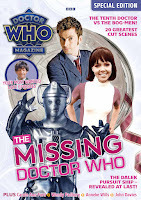 Out today, a new special edition of the official Doctor Who Magazine looks in detail at what's lost - from fans' most wanted missing episodes to the written but never made Tenth Doctor story by Mark Gatiss set in the British Museum.
Out today, a new special edition of the official Doctor Who Magazine looks in detail at what's lost - from fans' most wanted missing episodes to the written but never made Tenth Doctor story by Mark Gatiss set in the British Museum.I've also written or co-written three pieces:
Cut to the Chase, pp. 20-23
To accompany CG recreations by Gav Rymil, me and Rhys Williams detail the Dalek Pursuit Ship, mentioned in episodes 3-5 of The Daleks's Master Plan and then seen in episode 6, "Coronas of the Sun".
The Hole Story, pp. 32-35
There are 97 missing episodes of Doctor Who and, to date, 786 episodes existing in the BBC archives. But there are still bits missing from the latter - stuff broadcast but since lost, and stuff recorded but never shown...
The Final Countdown, pp. 44-49
Gav, Rhys and me again, this time on the sets for the last of the missing episodes, The Space Pirates Episode 6.
We've previously recreated sets from a bunch of missing episodes, so here's the list so far:
Galaxy 4 episode 2: Trap of Steel - DWM #583The Daleks' Master Plan episode 4: The Traitors - DWM #586The Daleks' Master Plan episode 6: Coronas of the Sun - DWM SE Missing Doctor WhoThe Daleks' Master Plan episode 7: The Feast of Steven - DWM #559The Tenth Planet Episode 4 - DWM #565The Power of the Daleks Episode 1 - DWM #584The Moonbase Episode 3 - DWM #562The Macra Terror Episode 1 - DWM #569The Evil of the Daleks Episode 1 - DWM SE Production DesignThe Abominable Snowmen Episode 1 - DWM #581The Wheel in Space Episode 1 - DWM #575The Space Pirates Episode 6 - DWM SE Missing Doctor WhoWhat's more, here's Andrew Orton's recreation of the sets from Marco Polo episode 1: The Roof of the World:See also: Me on Doctor Who missing episodes - so what?Buy my book on the largely missing story The Evil of the Daleks
July 28, 2024
Interview with Sefi Atta for Macfest
My interview last month with Sefi Atta, author of A Bit of Difference, is now available in full on YouTube.
The interview was part of Macfest; last year, for the same festival, I interviewed Fatima Manji about her book Hidden Heritage.
July 23, 2024
Shrines of Gaiety, by Kate Atkinson
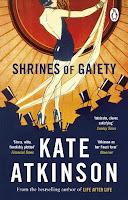 Two teenage friends, Freda and Florence, run away from home in York in 1926 and head to London to make their fortunes on the stage. Gwendolen Kelling, a friend of Freda's half-sister, agrees to try and find them. Miss Kelling teams up with Detective Inspector John Frobisher who is investigating the night clubs run by Nellie Coker, who has just been released from a six-month prison sentence. Coker, whose clientele includes the Prince of Wales and Aga Khan, is fighting her own battles. And someone is killing young woman and dumping them in the Thames...
Two teenage friends, Freda and Florence, run away from home in York in 1926 and head to London to make their fortunes on the stage. Gwendolen Kelling, a friend of Freda's half-sister, agrees to try and find them. Miss Kelling teams up with Detective Inspector John Frobisher who is investigating the night clubs run by Nellie Coker, who has just been released from a six-month prison sentence. Coker, whose clientele includes the Prince of Wales and Aga Khan, is fighting her own battles. And someone is killing young woman and dumping them in the Thames...These are just some of the many, many characters in this sprawling, 500-page novel. As with Atkinson's Case Histories , a number of stories are all happening at once, not always in chronological order. It's often warm and funny and yet there's an undercurrent of real threat. Many characters are haunted by their life-changing experience of war, which informs the violence. Mrs Kelling, for example, is a former nurse and knows how to deal with a bullet wound. Another shadow cast over events is the discovery, four years prior to the story being told, of the tomb of Tutankhamun. At one point, it almost seems credible that the ghost of the Egyptian pharaoh might be the one killing the young women.
Yet the novel stays in the realistic. It all feels real, too - the different clubs, each with their own vibe and clientele, all add to a rich and teeming sense of the metropolis and its many dangers. Gwendolen is figure I recognise from my reading of contemporary sources for my own Sherlock Holmes novel: an intelligent, able woman empowered by her war work and enjoying a new-found liberty to carve out her own role. (The fact she's unwittingly come into a great deal of money doesn't hurt.)
Atkinson lists a range of intriguing sounding sources in her author's note, but also admits that she has fudged some details - for example, one character has read The Murder of Roger Ackroyd , though this novel is set months before that was published. As she says, she's writing fiction not history and nothing jarred me out of the story.
There are some extraordinary coincidences - a girl called Gertie happens to look just like Freda and is in the wrong place at the wrong time, while a mother who comes to see Frobisher describes her daughter wearing a locket that is one of a very small collection of items we know Frobisher has already found. I think Ramsay Coker's efforts to write his own thrilling, insider's-eye novel about the "Age of Glitter" is a little on the nose. And there is also a little cheating, such as the shock 'death' of a character at the very end of a chapter (p. 361) who is later revealed merely to have fainted.
But that reprieve makes it all the more surprising at the end when a number of principal figures are bumped off abruptly. It's been a lively, fun adventure but we feel their loss, and we want to know what happens to the survivors. We last see Gwendolen hesitating over a question put to her by a man, and are left hanging as to what she might choose to do. There, I think, is scope for a whole new story...
July 20, 2024
Tomorrow and Tomorrow and Tomorrow, by Gabrielle Zevin
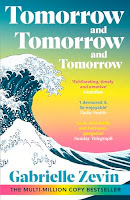 Various people recommended this captivating novel in which I’ve been completely immersed. That’s fitting, because it’s all about the solace of losing ourselves in something greater than ourselves — computer games chiefly but also fiction, imagination and friendship.
Various people recommended this captivating novel in which I’ve been completely immersed. That’s fitting, because it’s all about the solace of losing ourselves in something greater than ourselves — computer games chiefly but also fiction, imagination and friendship.Sadie Green meets Sam Masur (later Mazur) in hospital when they’re both children. They’re each going through some horrible, serious stuff at the time but bond while playing computer games. But Sadie has also not been entirely honest with Sam. Despite a falling out, they reconnect during college and collaborate on a game of their own…
We follow them for two decades through the highs and lows of their lives, the loves and losses and games.
It’s beautifully written and wryly observed, noting changes to games and the surrounding culture over the period. It’s also full of nuance: we can see Sadie’s tutor is a manipulative predator; she learns to see that, too, but remains his friend. For all he’s a monster, he’s a person, too.
At the heart of the novel is Sam and Sadie’s sparky relationship. At best, they are funny and supportive; at worst, they are jealous or brood on perceived slights. There are several recurring jokes, such as one — based on an old computer game — that Sadie has died of dysentery , which is part of their childhood banter and then gets dropped to blinding effect again on page 440.
In fact, it is constantly smart and witty, the wit all from the perspective of particular characters so also revealing about them and their understanding of the world. For example, there’s Sam in a particular crisis wishing he could reprogram his brain in the way he might fix a game.
“Unfortunately, the human brain is every bit as closed a system as a Mac.” (p. 228)
There’s lots of telling details, too, on the games these characters play — real and imaginary — and on their respective, mixed heritage: Sam’s Korean grandparents run a pizza place in K-Town, a district Sadie has never heard of when she first meets him, though she lives in a nearby part of LA. Later, they make a game out of separate but intersecting worlds.
The novel isn’t quite in chronological order, which allows it to tease the reader with key revelations to come. We jump ahead to interviews with Sam and Sadie looking back on their life and work. Or there’s the moment on page 190 when, in a scene set in the pizza place run by Sam’s grandparents, there’s the briefest mention of a poster on the wall: a 1980s advert showing a woman drinking a Korean beer. Twelve pages later, we learn the significance of this photograph - a gut punch of a revelation.
For a book about something as apparently unserious as playing games — a viewpoint it addresses several times — it is richly profound. More than once, we see the way games help people in real-life crisis. Sometimes, games have other impacts on real life, which I won’t spoil here. But it’s all utterly compelling; I read the last 100 pages on a plane yesterday, my heart in my mouth.
On that point, I can understand why the blurb and publicity don’t make a thing about this all being about games. That might put off readers who aren’t into games (I’m not, especially) — but can still be enthralled by the story being told.
One last idle thought. In her notes and acknowledgements at the end, author Gabrielle Zevin says that in referencing life-life computer games throughout the novel,
“I chose the games that made the most sense for the story, even when the dates were slightly wrong.” (p. 481)
That may illuminate an early reference that caught my eye. We’re told that Sam’s possessions in 1995 include,
“an aging desktop computer with a Doctor Who sticker on one side and a Dungeons and Dragons sticker on the other” (p. 67)
I wonder when Sam, aged 21 at this point, got into Doctor Who — a year before the TV movie kindled a new fandom and brought many lapsed fans back from the fray. I assume he was watching late-night on PBS. Did he find other like-minded fans, in real life or online, in the way he played Dungeons and Dragons with others? And when did his interest wane, as Doctor Who never gets mentioned again.
July 18, 2024
Doctor Who Magazine #606
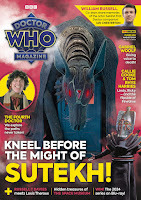 The new issue of Doctor Who Magazine is out today and boasts lots of exclusive, behind-the-scenes stuff about the recent TV series.
The new issue of Doctor Who Magazine is out today and boasts lots of exclusive, behind-the-scenes stuff about the recent TV series.I've written an article featured on the cover, "What If...?" exploring the near misses and never-were of the Fourth Doctor's era. It dovetails with the piece I wrote for the 50 Years of the Fourth Doctor special published in May, and was in part prompted by the panel about alternative history I was on at the Gallifrey convention earlier this year, which led to be revisiting the classic If It Had Happened Otherwise...
The new DWM also has news of something I've been involved in: six boxes of papers belonging to the late David Whitaker - first story editor of and prolific writer for Doctor Who - have been donated by his niece Melanie to the Borthwick Institute for Archives at the University of York. The Borthwick Institute website boasts more details and a catalogue of the David Whitaker archive. I've also written a piece on the papers in this collection relating to Doctor Who for DWM's Print the Legend special, currently in shops.
The Borthwick Institute is a very good fit for these papers because it already holds similar collections, including an archive relating to David's great friend producer Ernest Maxin. I visited the archive while researching my biography of David, as Maxin had kept two of his unproduced screenplays (see Maxin, box 14). I'm grateful to Gary Brannan at the institute for all his help.
July 11, 2024
Doctor Who: Ruby Red, by Georgia Cook
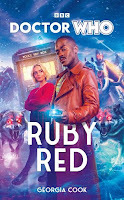 Responding to an alien distress call, the Doctor and Ruby arrive in Estonia a few days before the Battle of the Ice on 5 April 1242.
Responding to an alien distress call, the Doctor and Ruby arrive in Estonia a few days before the Battle of the Ice on 5 April 1242.
"'Big one,' the Doctor nodded. 'Well, small in scale, but big in everything else. The final bust-up between the invading Duchy of Estonia and the republic of Novgorod. Marks the end of the Northern Crusades in this region, and cements Prince Alexander Nevsky as a national hero.'
'I've never heard of it,' said Ruby.
'Your planet's had too many wars for anyone to know them all,' said the Doctor sadly. 'Still, here we are.'" (p. 30)
The distress signal has been sent by Ranavere, a 16 year-old girl from an alien culture of warriors, who has been sent to the battle as part of a coming-of-age ritual. Ranavere doesn't to fight - but it soon turns she may not have a choice. There are other aliens on the ice, some of them more of Ranavere's warmongering people and then there's something more monstrous as well...
I really enjoyed this fast-moving, lively adventure by first-time novelist Georgia Cook (who I know a bit). It deftly captures the pace and verve of the recent TV series. In fact, it's packed with set-piece moments that would be great to be able to see. This is a book that would really suit illustration - which should come as no surprise given that the author is also a designer and artist.
Ruby and the Doctor are captured well, and Ranavere is a character we can relate to; she and her family are well drawn. Like Ruby, I'd never heard of this moment in history but it makes for a rich, arresting backdrop. It's all great fun, not least towards the end when, after all the ice and cold, the Doctor emerges from the TARDIS with a pile of big, fluffy towels for the surviving burly warriors. Their resistance to such comfort quickly melts, in a moment that's perfectly daft, funny and true to character.
July 10, 2024
Doctor Who: The Time-Travelling Almanac
 The official Doctor Who website has announced my new book, The Time-Travelling Almanac, to be published on 3 October. It is illustrated by Emma Price.
The official Doctor Who website has announced my new book, The Time-Travelling Almanac, to be published on 3 October. It is illustrated by Emma Price.Blurb as follows:
Experience a year from the Doctor's perspective with an exciting new release from BBC Books.
“The ground beneath our feet is spinning at a thousand miles an hour and the entire planet is hurtling round the sun at 67,000 miles an hour, and I can feel it.”
– The Doctor
Doctor Who: The Time-Travelling Almanac is your essential companion to a Time Lord’s ‘Year’. You’ll learn how to feel the turn of the Earth under your feet (hurtling round the sun at 67,000 miles an hour), the times each day that Sea Devil attacks are most likely (depending on the tides), how to avoid disturbing dangerous faeries (distances measured in yards), and why, despite all the invasions and Goblins, Christmas is the most wonderful time of the year.
Releasing later this year, The Time-Travelling Almanac is a must-have guide with useful tips and information provided by the Doctor and friends – and occasionally his enemies.
Doctor Who: The Time-Travelling Almanac is out in hardback on October 3rd 2024. You can pre-order here.
July 8, 2024
Wrights and Chestertons in Kensington
I was in London for a bit on Saturday to attend the live recording of the final Eggpod, where I caught up with several good friends. Having allowed a bit of extra time for the usual snafu of trains, I had half an hour to retread a couple of streets relating to David Whitaker and the early days of Doctor Who.
Doctor Who is generally seen as the creation of BBC head of drama Sydney Newman and his head of serials, Donald Wilson. As detailed in the production diary, having agreed a format for the new series in May 1963, on 4 June Wilson sent Newman an outline for the first four-part serial, The Giants, written by staff writer CE Webber. The Doctor's companions in this were school pupil Sue and her teachers Lola [McGovern] and Cliff.
Newman objected to this storyline and another staff writer was brought in to write the first story. In Coburn's first draft script (reworking CE Webber's original), Lola became Miss McGovern and Cliff became CE Chesterton, with Sue now "Susan Forman" and established as the Doctor's granddaughter.
In Coburn's next draft, Miss McGovern became Miss Canning and Susan became Susanne Forman, though it was also revealed that she was in fact an alien princess called Findooclare. Story editor David Whitaker wasn't sure about this last element, as he explained in an undated note to producer Verity Lambert. But he added that Coburn "agrees to the change of any names we wish."
By the time the episode was recorded in September, the characters were established as Susan Foreman (granddaughter of the Doctor but her origins left a mystery), Barbara Wright and Ian Chesterton.
A detailed analysis of these different drafts was published in Doctor Who Magazine in 2013, written by my friend Graham Kibble-White (who I sat with at Eggpod on Saturday). This included an interview with the son of the late Anthony Coburn, in which Stef Coburn claimed that his (Catholic) father had based the character of the Doctor on his "cultural hero St Paul" and had named one school teacher after another of his heroes, the flamboyant writer GK Chesterton. The feature went on to speculate that GK Chesterton's The Ballad of Saint Barbara (1922) was an influence on the name of Ian's colleague.
I'm not so sure about this, not least because the characters in Doctor Who aren't really anything like St Barbara, GK Chesterton or St Paul. In researching my book on David Whitaker, I walked the streets of Kensington where he'd lived for much of his life, and spotted an alternative. I contend that this fits with Whitaker's note to Lambert, which implies that they - not Coburn - changed the characters' names.
On 8 June 1963, Whitaker married actress June Barry, who lived with her mum in Cheniston Gardens, W8 - the doorway in the extreme right of this picture I took on Saturday.
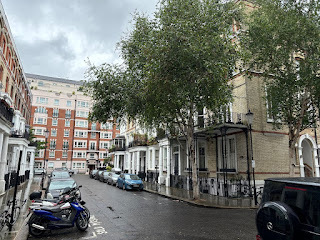
But what’s that straight ahead?
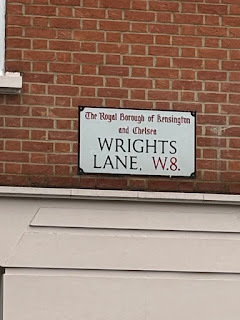
Turn left up Wrights Lane and you’re heading north, just a hundred yards or so to Kensington High Street. That's in the direction David lived at the time (with his parents, on nearby De Vere Gardens), and also in the direction of Peel Street, home to David’s brother Robert and his wife Barbara…
In making the shortish walk to Peel Street, you cross Kensington High Street and on to Hornton Street, home to this well-established estate agent.

In 1963, it was based at 116 Kensington High Street, so would have been even more prominent. David Whitaker and his bride may well have used Chestertons, their local estate agent, to find a place of their own to live - after their wedding, they moved to Russell Gardens Mews and lived there until 1970.
Keep going up Hornton Street and you get to a road running parallel to Peel Street; there's a plaque at no. 32 Sheffield Terrace marking the fact that GK Chesterton was born there on 29 May 1874. So Chesterton in Doctor Who may well have been named after the writer, but through this local connection.
All of this is a stone's throw from St Mary Abbots Church:
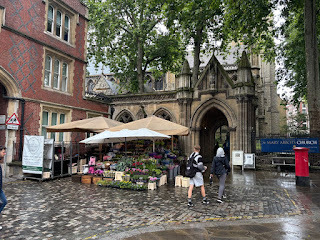
This is where David and June married, James Beck and Trevor Bannister among their ushers, Alethea Charlton their bridesmaid - as seen in the film clip included in our Looking for David documentary on the Doctor Who Season 2 collection. Charlton, of course, played Hur the cavewoman in Coburn's opening serial for Doctor Who.
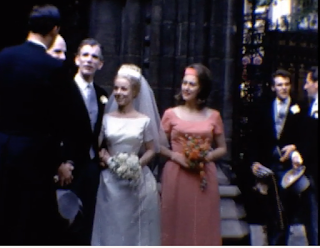
I'd not been inside the church before Saturday (it was closed when I was last there as Covid restrictions still applied), which also isn't featured in the wedding film. It is pretty fancy. Information displayed there says Richard Attenborough was once one of the parishioners.
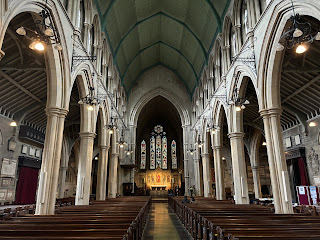
That church is opposite a department store with the same name that Doctor Who producer John Nathan Turner later used to describe hyper obsessive fans. Hello.
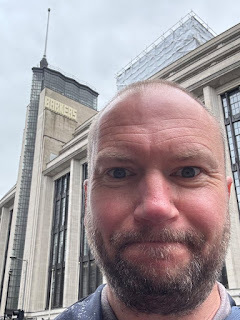
July 4, 2024
Whotopia #43
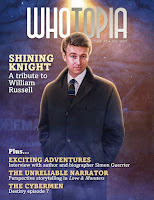 Issue 43The new issue of free online Doctor Who fanzine Whotopia* is now available, and includes a tribute to the late actor William Russell plus "Exciting Adventures" - an interview with me by Reecy Pontiff.Download Whotopia #43 (PDF)Whotopia websiteReecy Pontiff's website* Not to be confused with the book Whotopia for which I did some of the writing.
Issue 43The new issue of free online Doctor Who fanzine Whotopia* is now available, and includes a tribute to the late actor William Russell plus "Exciting Adventures" - an interview with me by Reecy Pontiff.Download Whotopia #43 (PDF)Whotopia websiteReecy Pontiff's website* Not to be confused with the book Whotopia for which I did some of the writing.
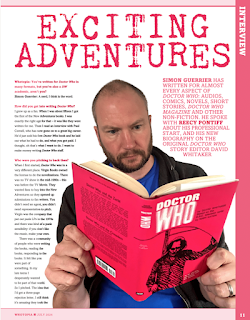
Simon Guerrier's Blog
- Simon Guerrier's profile
- 60 followers



